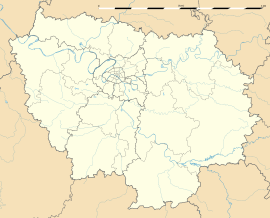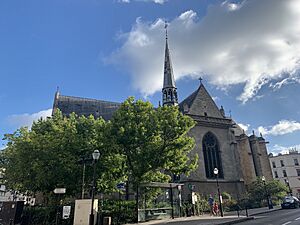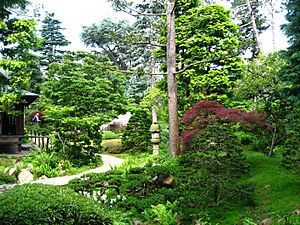Boulogne-Billancourt facts for kids
Quick facts for kids
Boulogne-Billancourt
|
||
|---|---|---|
|
Subprefecture and commune
|
||
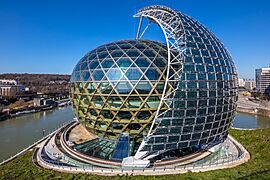
La Seine Musicale on Île Seguin in the Seine
|
||
|
||
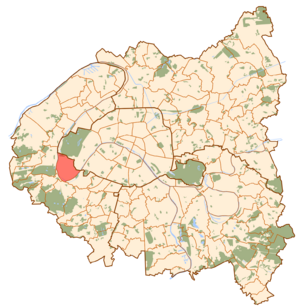
Paris and inner ring departments
|
||
| Country | France | |
| Region | Île-de-France | |
| Department | Hauts-de-Seine | |
| Arrondissement | Boulogne-Billancourt | |
| Canton | Boulogne-Billancourt-1 and 2 | |
| Intercommunality | Grand Paris | |
| Area
1
|
6.17 km2 (2.38 sq mi) | |
| Population
(2021)
|
119,808 | |
| • Density | 19,418/km2 (50,290/sq mi) | |
| Time zone | UTC+01:00 (CET) | |
| • Summer (DST) | UTC+02:00 (CEST) | |
| INSEE/Postal code |
92012 /92100
|
|
| Elevation | 28–40 m (92–131 ft) | |
| 1 French Land Register data, which excludes lakes, ponds, glaciers > 1 km2 (0.386 sq mi or 247 acres) and river estuaries. | ||
Boulogne-Billancourt is a lively city in the western suburbs of Paris, France. It's often just called Boulogne. This city is about 8 kilometers (5 miles) from the center of Paris. It's a very important city in the Hauts-de-Seine area. Boulogne-Billancourt even has its own island in the Seine River, called Île Seguin.
This city is known for being one of the richest areas near Paris. It used to be a big industrial center. Now, it's a hub for business services. Many major communication companies have their main offices here.
Contents
What's in a Name?
The city's first name was Boulogne-sur-Seine. This meant "Boulogne upon the Seine River".
Long ago, before the 1300s, it was a small village. Its name was Menuls-lès-Saint-Cloud. This meant "Menuls near Saint-Cloud". In the early 1300s, King Philip IV of France ordered a church to be built there. This church was for the Virgin Mary. It was named Notre-Dame de Boulogne la Petite. This means "Our Lady of Boulogne the Minor". It was meant to be a pilgrimage spot closer to Paris. Over time, the village became known as Boulogne-la-Petite. Later, it was called Boulogne-sur-Seine.
In 1924, the city officially changed its name. It became Boulogne-Billancourt. This new name showed that the industrial area of Billancourt had grown. Billancourt was added to the city in 1860.
The name Billancourt was first written down in 1150. It was spelled Bullencort or Bollencort. It comes from an old word meaning "estate" or "enclosure". It was likely the "estate of Buolo," a Germanic name.
A Look Back in Time
On January 1, 1860, the city of Paris grew bigger. It took in parts of nearby towns. At this time, Boulogne-Billancourt (then called Boulogne-sur-Seine) gained some land. It received parts of the areas called Auteuil and Passy. This included the Billancourt area.
Boulogne-Billancourt was a host city for the 1900 Summer Olympics. Some of the shooting events took place here.
In 1929, a large park called the Bois de Boulogne became part of Paris. Before this, it was shared between Boulogne-Billancourt and another town. When Paris took over the park, Boulogne-Billancourt lost about half of its land. Since then, the city has been surrounded by the Seine River on three sides. Paris is to its north and northeast.
Boulogne-Billancourt is famous for being the start of three big French industries:
- Aviation: The very first aircraft factory was built here in 1906. It was called Appareils d'Aviation Les Frères Voisin. Many other airplane pioneers followed. Today, several aviation companies still work in the area.
- Automobiles: The car industry was also very important. Companies like Renault had a large presence on Île Seguin. Salmson built both cars and aircraft engines here.
- Film: The French film industry began in Boulogne-Billancourt. From 1922 to 1992, it was home to the Billancourt Studios. It's still a major place for French film production. The TV show Code Lyoko was even set here.
How Many People Live Here?
| Historical population | |||||||||||||||||||||||||||||||||||||||||||||||||||||||||||||||||||||||||||||||||||||||||||||||||||||||||||||||||||
|---|---|---|---|---|---|---|---|---|---|---|---|---|---|---|---|---|---|---|---|---|---|---|---|---|---|---|---|---|---|---|---|---|---|---|---|---|---|---|---|---|---|---|---|---|---|---|---|---|---|---|---|---|---|---|---|---|---|---|---|---|---|---|---|---|---|---|---|---|---|---|---|---|---|---|---|---|---|---|---|---|---|---|---|---|---|---|---|---|---|---|---|---|---|---|---|---|---|---|---|---|---|---|---|---|---|---|---|---|---|---|---|---|---|---|---|
|
|
||||||||||||||||||||||||||||||||||||||||||||||||||||||||||||||||||||||||||||||||||||||||||||||||||||||||||||||||||
| Source: EHESS and INSEE (1968-2017) | |||||||||||||||||||||||||||||||||||||||||||||||||||||||||||||||||||||||||||||||||||||||||||||||||||||||||||||||||||
City Life and Buildings
Boulogne-Billancourt has a special "ecologic neighborhood" called the Trapèze. This area is huge, covering 74 hectares. It will eventually be home to up to 18,000 people. A lot of the energy for this district comes from geothermal power. This means using heat from the Earth to warm and cool buildings. Solar panels and a vegetable greenhouse are also used. The goal is to make the district very eco-friendly. Walking and biking are encouraged to reduce pollution from cars.
The Ambroise Paré Hospital is also located in the city.
Getting Around
Boulogne-Billancourt is easy to reach by public transport.
- Two stations on Paris Métro Line 10 serve the city: Boulogne–Jean Jaurès and Boulogne–Pont de Saint-Cloud.
- Three stations on Paris Métro Line 9 also serve it: Marcel Sembat, Billancourt and Pont de Sèvres.
Business and Jobs
Boulogne-Billancourt is home to the main offices of many big international companies. Some of these include:
- Alcatel-Lucent (a telecommunications company)
- Carrefour (a large supermarket chain)
- Française des Jeux (the national lottery)
- Renault (a famous car manufacturer)
- TF1 (a major French TV channel)
- Yoplait (a well-known yogurt brand)
Places to Visit
- The Musée Albert-Kahn is a national museum. It has beautiful gardens that show different national styles. The museum also displays old photographs and films.
- The Musée des Années Trente is a museum that shows art and industrial items from the 1930s.
Learning and Schools
Boulogne-Billancourt has several public middle schools, called collèges. These include Jacqueline-Auriol, Bartholdi, Paul-Landowski, and Jean-Renoir. The public high schools are the Lycée Jacques-Prévert and the Lycée Polyvalent Étienne-Jules-Marey.
There are also private schools like Groupe Scolaire Maïmonide Rambam, which teaches students from kindergarten to high school. Notre-Dame is another private high school.
A special Japanese education program, Association Eveil Japon, is also located here. A campus of the École supérieure des sciences commerciales d'Angers, a business school, is in the city too.
Famous People from Boulogne-Billancourt
Many well-known people were born in Boulogne-Billancourt. Here are a few examples:
- Leslie Caron (born 1931), a famous film actress and dancer.
- Matthieu Chedid (born 1971), a talented composer, singer, and guitarist.
- Laurent Garnier (born 1966), a popular electronic music producer and DJ.
- Patrick Modiano (born 1945), a writer who won the Nobel Prize in Literature in 2014.
- Zazie (born 1964), a well-known singer-songwriter.
- Gaspard Ulliel (1984-2022), a respected actor and model.
City Connections Around the World
Boulogne-Billancourt is connected to other cities around the world through "twinning" programs. This means they share cultural and educational exchanges.
 Anderlecht, Belgium
Anderlecht, Belgium Hammersmith and Fulham (London), England, United Kingdom
Hammersmith and Fulham (London), England, United Kingdom Neukölln (Berlin), Germany
Neukölln (Berlin), Germany Marino, Italy
Marino, Italy Pančevo, Serbia
Pančevo, Serbia Ra'anana, Israel
Ra'anana, Israel Irving, United States
Irving, United States Sousse, Tunisia
Sousse, Tunisia
See also
 In Spanish: Boulogne-Billancourt para niños
In Spanish: Boulogne-Billancourt para niños




